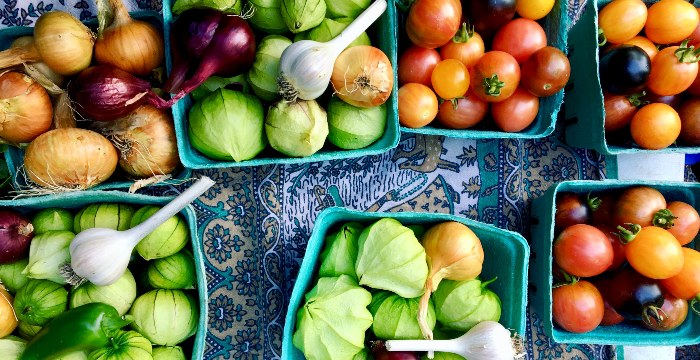
Eco-Explainer: What Are Genetically Modified Organisms (GMOs)?
Since scientists first began testing genetically modified crops in the 1980s, GMOs have espoused fear and controversy. But what are the pros and cons?
Stores like Sprouts Farmers Market, Mariposa Food Co-op, and MOM’s Organic Market are immensely popular among Philadelphia residents committed to organic food consumption.
While there are numerous benefits to supporting local grocers, farmer’s markets, and co-ops, consumers often flock to these vendors because of the assumption that genetically modified organisms (GMOs) are unnatural and pose a health risk.
However, there are many misconceptions about what GMOs are, the effects they have on our health, and the role they play in our immediate communities and global food systems.
The Definition
The National Library of Medicine defines GMOs as genetically engineered foods that have had their DNA altered using genes from other plants or animals. While this sounds alarming, the process has been conducted safely for decades. Crops are altered to make foods more nutritious, tasty, and even disease or drought resistant.
Want to learn more? Here are answers to some commonly asked questions that will add nuance to your perspective.
Are GMOs Unhealthy for Humans?
There is no proof that genetically engineered foods are unhealthy. GMOs have been on the market for over 20 years, and the National Academies of Science agrees with scientists and U.S. regulatory agencies that consuming genetically modified crops is no riskier than eating food with ingredients derived from conventional plant breeding techniques. However, many of the studies concluding that GMOs are as safe as conventional foods were performed by biotechnology companies or their associates, so no objective conclusion has been reached.
While the effects of GMOs on our health are obscure, the use of toxic herbicides like Roundup® on crops due to GMO herbicide tolerance are proven to be detrimental to human health. In March 2015, the World Health Organization classified the powerful herbicide as “probably carcinogenic to humans” after reviewing about 1000 studies of those exposed to glyphosate through their jobs and other experimental cancer studies.
Transparency about the presence of GMOs in food is also ambiguous at best in the United States. There may be unhealthy processed GMO inputs unknowingly incorporated into your food, as only some products are labeled under the National Bioengineered Food Disclosure Standard (NBFDS), also known as the DARK Act. While there isn’t currently a foolproof way to avoid GMOs due to categorical exemptions in the law, it aims to have most products labeled by 2022.
Are GMOs Harmful to Small Farmers?
While GMO production is not itself harmful to small farmers, some of the corporations that have control over GMO technologies certainly are. Monsanto, a leading agrochemical and biotechnology corporation, is notorious for suing farmers to protect its seed patents.
Their legal entanglements have grown more pernicious in recent years. In 2019, soybean farmers in Brazil sued Monsanto for a royalty collection system that they claimed violates their planting rights. The Brazilian court ruled against the farmers, an unsurprising decision given the history of North American farmers who have been forced to pay thousands of dollars to Monsanto over the use of commodity seeds.
There have also been instances where GMO crops have mysteriously appeared on farms, like the GMO wheat discovered on an Oregon field in 2013. These freak occurrences threaten the financial well-being of farmers whose consumers are vehemently against genetically modified crops—ultimately wreaking havoc on wheat sales.
Do GMOs Hurt the Environment?
Crops do not cause harm simply because they are genetically modified, and the farming practices used for non-GM and GM crops have similar environmental effects. However, there are precautions that must be taken when using genetically engineered crops to increase environmental gains.
“Generally, GE crops have had fewer adverse effects on the environment than non-GE crops produced conventionally,” concluded the National Research Council in 2010. However, they note that it is important to tread carefully and maintain a variety of agricultural practices. “Excessive reliance on a single technology combined with a lack of diverse farming practices could undermine the economic and environmental gains from these GE crops.”
Agricultural diversity helps to prevent an onslaught of environmental damage due to pesticide use as well. A combination of organic and industrial-level farming is not only key to supplementing our industrial food sources, it also helps to boost agricultural land health.
What’s the Deal with GMO Labeling Laws?
In 2017, the government passed a national GMO labeling law stating there must be a uniform standard for marking bioengineered foods. Companies are required to comply with the new rule by January 1, 2022.
These GMO labels will take three forms: text on food packaging, a symbol that represents bioengineering, or a digital link that can be scanned.

The symbols that the United States Department of Agriculture (USDA) will require for GMO labeling, courtesy of Illinois Farm Families.
Despite the labeling law, GMO symbols will likely continue to be subtle and easy to miss. Monsanto, the biggest lobbying spender in the agricultural industry, spent $3.7 million in 2018 and about $2.5 million in 2016 to make it harder for shoppers to interpret labeling of genetically modified foods.
Although the U.S. is still in the early stages of implementing GMO-related legislation, over half of the 28 countries in the European Union have prohibited their farmers from growing genetically modified crops. The ban is primarily due to concern over the effects of biotechnology, but has been complicated by European countries’ reliance on imported GM fodder for livestock.
Since there are varied regulations throughout the world, international markets make it difficult for GMO bans and regulatory policies to be all-encompassing or effective.
Do GMOs Help Feed the World?
The world population is expected to reach nearly 10 billion people by 2050 according to the United Nations, and GMOs will have to play a role in securing nutritious foods for every corner of our growing global community.
Genetic modification techniques have been successful in saving frequently-consumed crops from persistent diseases, such as the Hawaiian rainbow papaya plagued by ringspot virus. And for vital commercial crops that are susceptible to disease, GMO technology will be crucial in preventing shortages caused by failed and diseased harvests.
To supplement this, centering local interests in areas facing hunger is necessary. Nobel laureate Amartya Sen proved that famine is a problem of democracy, poverty, and food distribution rather than solely a shortage of food, with possible solutions like a combination of protected land sovereignty and distribution of GM crops that can survive and provide adequate nutrition.
The jury may still be out on the overall effects of GMOs.
One thing we learned from the recent pandemic is the fragility of global supply chains, leading to food shortages. An increase in small-scale, local farming can help mitigate the effects of hunger (and carbon emissions) in the coming years.









